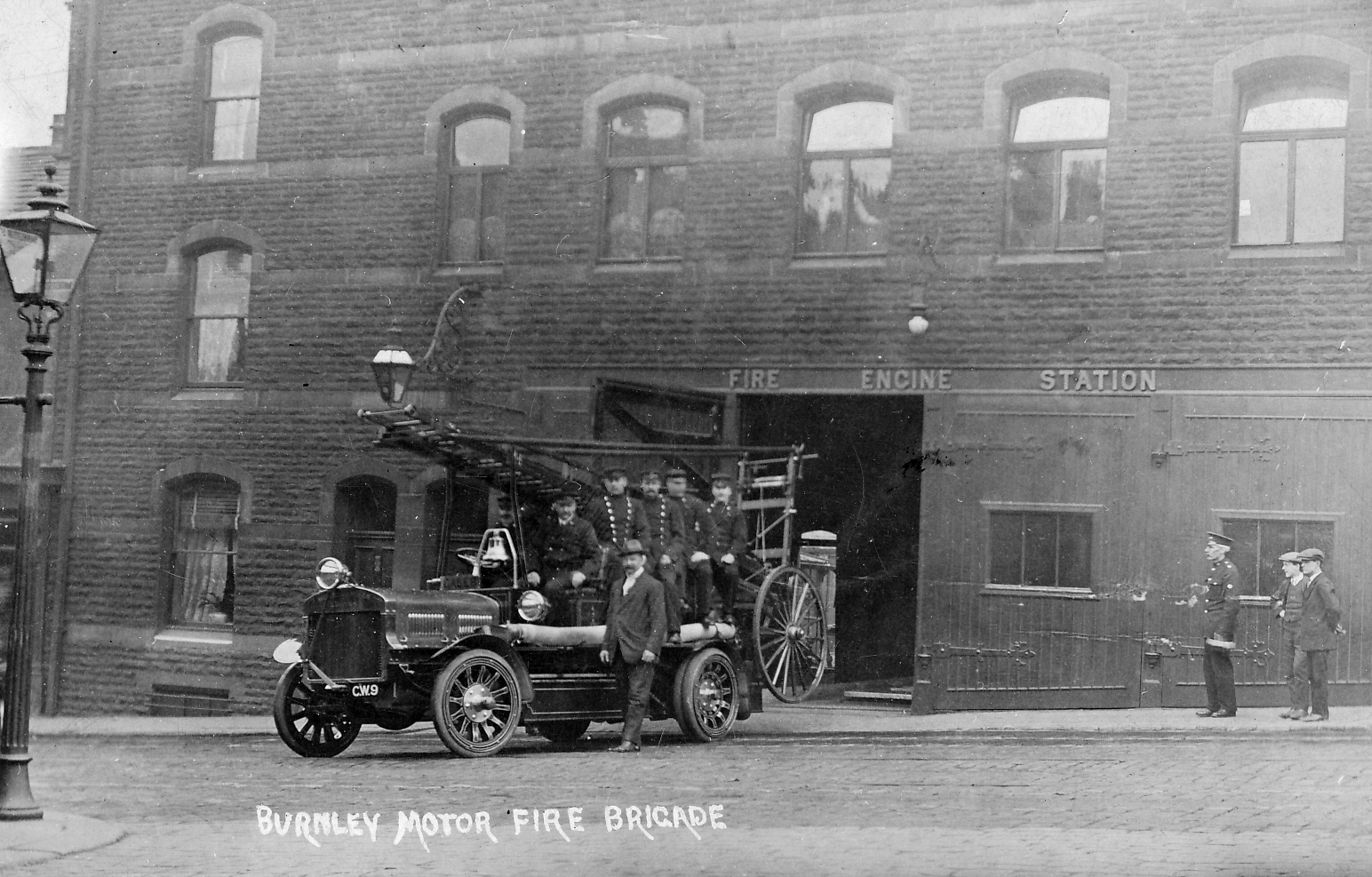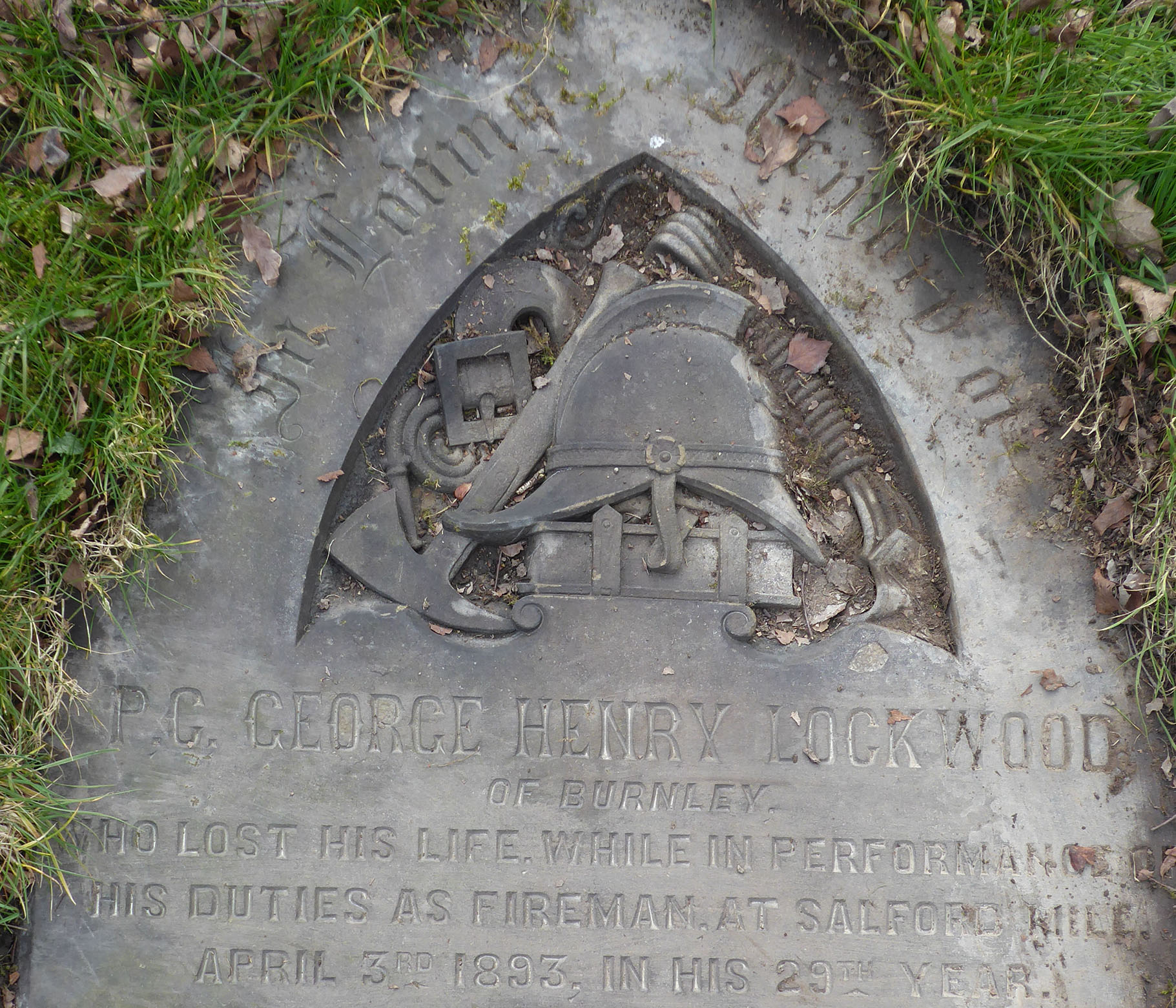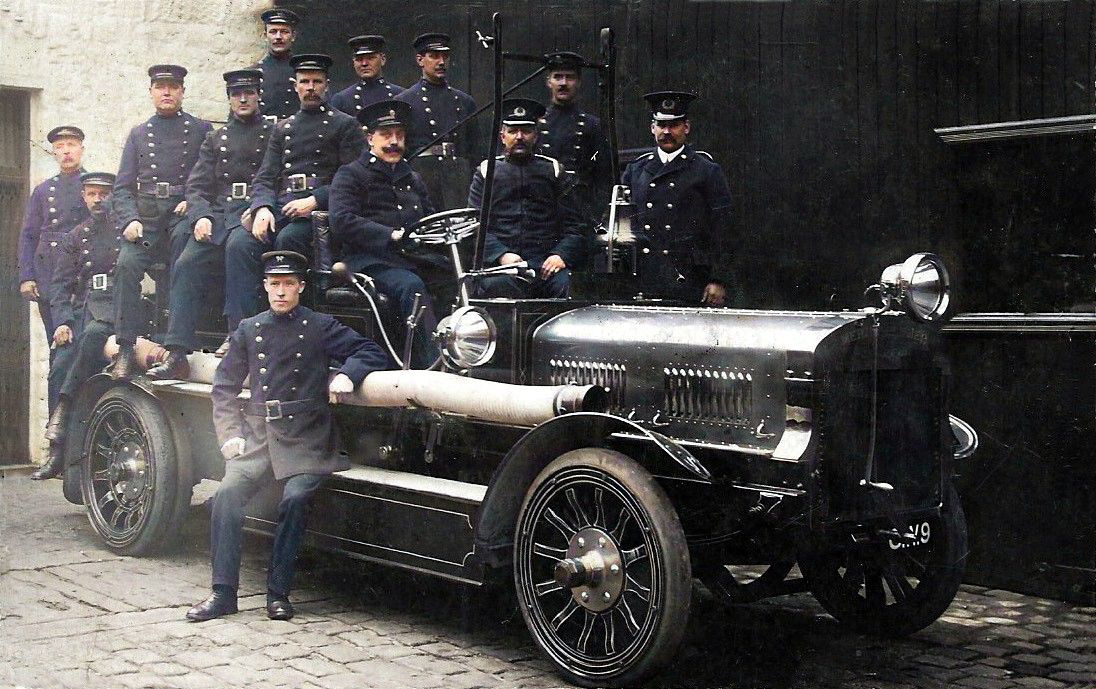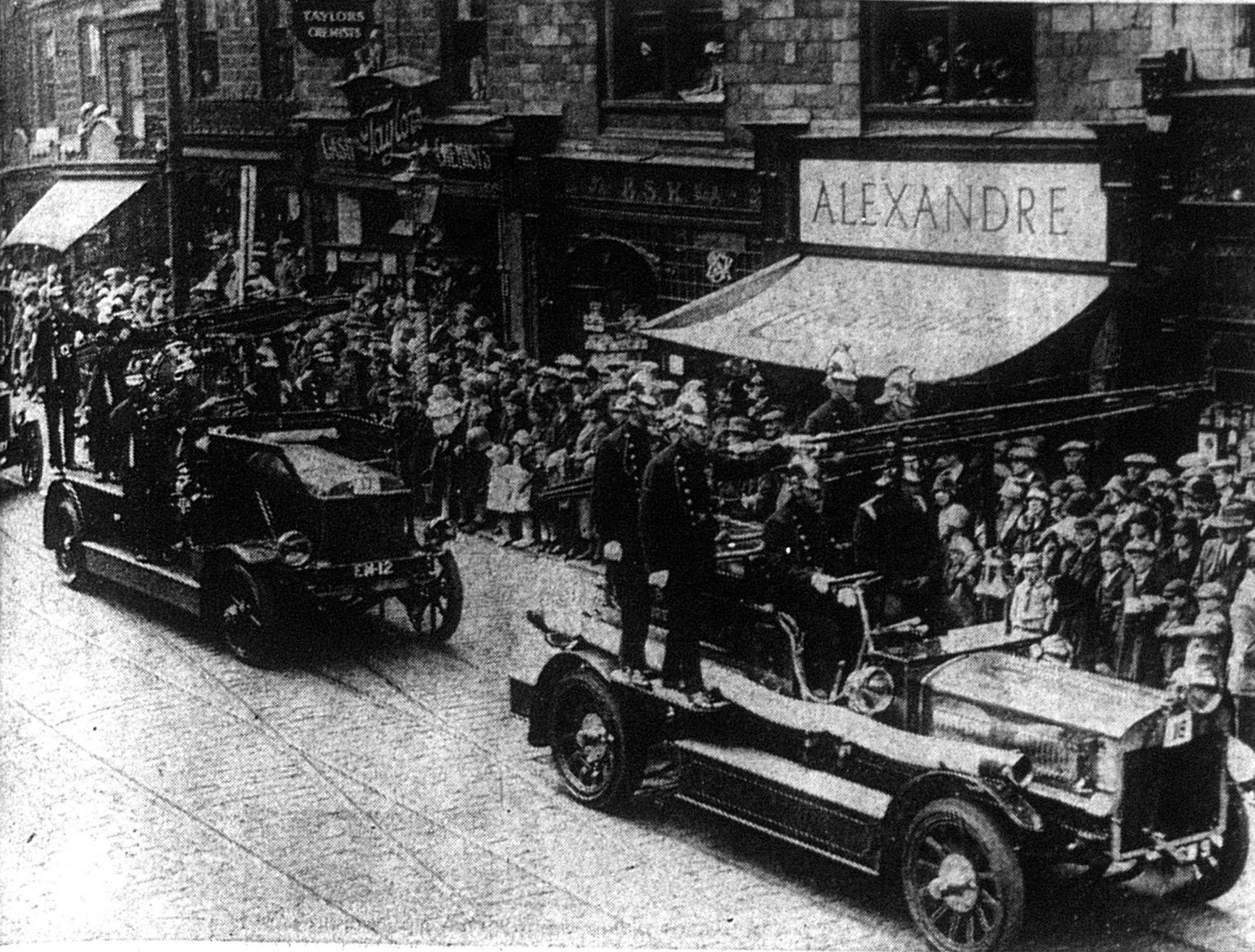Burnley Fire Brigade
First Hundred Years


1861 - BA Aug 10 - The proposal for an auxiliary fire service to be formed.
1874 - BA June 6 - Authorised to modernise the firefighting equipment - Steam engine Calder.
1880 - BE Dec 11 - Moved to Manchester Road.
1881 - A telephone system installed.
1888 - BE Jan 11 - Steam engine Brun was acquired.
1891 - The Police became responsible for the extinguishing of all fires.
1912 - BE Oct 12 - New engine Christened Caleb in honour of Alderman Caleb Thornber.
1921 - BE Jan 12 - New engine Christened Heaton in honour of Alderman JA Heaton.
1923 - BE Aug 1 - A New Merryweather (London) engine is bought.
1929 - BN Mar 13 - New engine built by Morris-Dennis.
1950 - BE Jul 29 - Burnley Brigade get their first radio communications equipment.
1950 - September Outline plan for a new fire station approved by Watch & Fire Brigade Committee.
1965 - BE May 5 - Move to New HQ on Blevedere Road
Between the 17th century and the beginning of the 19th century, all fire engines and crews in the United Kingdom were either provided by voluntary bodies, parish authorities or insurance companies.
Before 1938, there were some 1,600 local fire brigades in operation. The Fire Brigades Act 1938 constituted the councils of all county borough and county districts (municipal boroughs, urban and rural district) as fire authorities. The councils were required to provide the services for their borough or district of such a fire brigade and of such fire engines, appliances and equipment as may be necessary to meet efficiently all normal requirements.
Burnley Advertiser dated Saturday 10 August 1861
The minutes of the Water Committee were read and referred to a recent fire. It was stated that the large engine broke down in consequences of the people interfering with the pipe; and that 150 yards of hose had been spoiled by being trampled upon.
The Towns Commissioners of 1854 - 1861 had grave doubts about the principle of levying rates to buy equipment which could only be used to save the private property of millowners and householders. They therefore circularised Fire Insurance Companies, which might benefit from the use of more up-to-date appliances, and asked for contributions towards the cost of re-equipping the Fire Brigade. It was also suggested that it would be of great service in cases of fire if each manufacturer would supply two or three men as a staff to act as constables. The replies were far from satisfactory to the Commissioners and the question of modernising the Brigade was indefinitely postponed.
Later a new small engine worked by 6 men was brought to Burnley on trial. It would cost 45 pounds and pump 100 gallons per minute, unfortunately it broke down during the demonstration and even when working was no better than an ancient machine already owned by the corporation.
However, the Water-works Manager was appointed Fire Chief, probably in the hope that he would use the small supply of water as sparingly as possible, and it is said that before operating at any fire the Officer in charge made certain whether the threatened building was insured, and if not, who would pay for the water and the Fire Service.
New Management
This policy created so much dissatisfaction that Christopher Slater, Inspector of Nuisances, was put in charge of the Fire Brigade and held the position for 31 years, 1860 - 1891. At first he was paid 5/- for attending an alarm, 10/- for the first hour at a fire with I/- for each other hour, and 3/- for a practice. Members of the Brigade were accustomed to make a little extra money by house-to-house collections at Christmas but in 1871 they accepted an annual gift of 21 pounds in lieu thereof.
Suggestions had been put forward in 1864 that the Council should buy a new steam fire-engine and a fire-float to be put on the canal and insist that fireplugs should not be more than 100 yards apart. Little or nothing was done to carry out the proposals and in 1873 equipment consisted of two hand-engines of which nobody knows the age or origin, and one pipe-reel which was expected to come to pieces the next time it was used. In general the Brigade relied on the pressure in the water mains rather than the manual pumps to give a jet but this help was denied in mill fires because fire-plugs (hydrants) had been removed from mill-yards when it was found that they were used for filling mill boilers without the water being paid for.
Burnley Improvement Act


The New Steam Fire Engine - Calder
In June 1874 there was a proposal to the Town Council -To authorise the purchase of a new pipe reel carriage, a hand fire engine, and a steam fire engine, together with the necessary pipes and other apparatus, at an estimated cost of 1,550. Although the mayor expected only a small opposition to the proposal, the voices against were loud - Fifteen hundred and fifty pounds isn't a sum to be winked at.
The chairman placed before the Council the present condition of the fire department, from which it was clear that so far as the fire apparatus is concerned it is all but 'done up', next to useless; and it would't be at all matter for surprise were a total breakdown to occur on the occasion of a fire. 'It is the duty' he said, 'of the Corporation to provide means for the extinguishing of fires'. The fact was that the Burnley Improvement Act imposed this duty on the Corporation.
He went on to argue that 'all they had of the old was worn out. The two engines of which they were possessed as to their origin stretched beyond the memory of living men. Nobody could tell whence they came, the sooner they reached oblivion at the other end the better. Two new engines they must have, with all that was required with them, and if the steam fire engine was not to be one of them, in refusing it the Council would virtually be admitting that they had not made the best provision they could and ought to have made'. Needless to say the mayor won the day.
At that time Burnley had an artisan fire brigade under the command of Supt. Slater, who, besides holding this office, was the sanitary inspector for the borough. This brigade was constituted of 24 men, twelve of these being firemen, and the remainder the reserves. Their new fire engine was named 'Calder' - The Steam Engine photographed above.
The history of Burnley's fire brigade goes back many years, but finding interesting first-hand accounts is quite difficult.
One that I have found was published in the Burnley Express in December 1934. It is the reminiscences of a 74-year-old whose father had been the Deputy Superintendent of the brigade in the 1870s. She tells the tale of one of the first outings of the then new steam fire engine (Calder).
In those days the members of the brigade were paid a certain amount for each fire they attended, and in the case of a false alarm, the amount was smaller. Most of the members were workmen, and when the fire bell rang at the Fire Station, they had to leave their work immediately and rush to the engine. It often happened that they were working on ladders or on a roof of buildings in the neighbourhood, and there would be a hasty scramble for the ground. Then followed a dash to the Fire Station, where the engine was being prepared. The wives, or members of the families of the firemen, had instructions when they heard the summons to the station to run there with the firemen's uniforms and on some occasions it was a strange sight to see a number of women and children running towards the station with bundles of clothing.
When the firemen reached the fire Station, they were not ready to start on their way to the fire, there was still one important duty to be undertaken. Some members had to rush off to Plumbe Street to a carriage company and get horses to draw the engine. After horses had been taken back to the Fire Station and hitched to the engine, then the brigade was ready for action.
When the steam engine arrived, there was a lot of confusion when they attended their first fire. All was ready at the Fire Station, waiting for the signal to go when it was discovered that the chimney from the engine was missing. A hasty search was made, but it could not be found. Time was valuable, so the engine set off without its handsome brass bound ornament. A surprise was in store for the firemen, however, for when they arrived at the fire they found that one of their comrades had run on ahead with the all-important chimney under his arm.
New Fire Station

At a cost of 1,250 in December 1880 the building in Manchester Road opened as the new fire station, it was supplied with fire valve from the town's mains and cisterns. There was one steam engine 'Calder', one manual engine, one hose-cart 'worn out' two jumping sheets, eight ladders, 66 lengths of hose and the town had 248 hydrants. 'Burnley Express Sat 11 Dec 1880'. A year later eight telephones points were deployed in various parts of the town to summon the brigade; and ladders were also kept at those points.
The Borough Police Force was formed in 1887 and took possession of the fire station and twelve men were stopped, and twelve police put in their places, the brigade then being 24, 12 each police and artisans.
In January 1888 a second engine 'Brun' was acquired at a cost of 822 - one report suggests that it was in good condition but second hand. The question asked was how is it better than our existing engine 'Calder'?
It was explained that the new engine, although similar to Calder was 10 bhp more powerful, less complicated and therefore easier to use and faster to get up to maximum pressure, although both Brun and Calder were capable of pumping 900 gallons of water per minute. At the demonstration held at a mill alongside the canal the horses were detached, the fire was lit, a 6-inch suction pipe was laid from the canal, and three 3-inch outlet pipes were then affixed to the engine. It took 8mins 30secs to reach a working pressure of 100lbs.
In November 1891 the Police became responsible for the extinction of all fires under the charge of the Corporation.
Another First Hand Account
William Goom served in the Royal Navy from 1876 to 1886 and then employed in the Burnley Mechanics' Institute. The following paragraph is from his book 'The Cares of a Burnley Caretaker' were serialised in the Burnley Express.
'I well remember the day when the Borough Police Force was formed and took over the duties of the Fire Brigade. The firemen were all raw recruits and had to have much drilling in climbing ladders and descending from high buildings down canvas chutes. Inspector Dunn, knowing of my experiences in the Navy, often asked for my assistance in drilling the men, particularly with the new fire escape, which was kept in the police yard. The escape, which extended to a height of about 60 feet, was put against the school wall, and I would demonstrate how to climb and descend. Then the recruits tried to follow my example, most of them making an awful mess of it. Some would go up almost doubled in two, others would get up about half-way, and some would not get even so far. Had there been a fire at the top of the building, it would surely have been burnt out before some of them got near it. However, by a little judicious sorting out, the foundation of the present efficient Fire Brigade was laid. I remember two of the new men, George Nuttall and J. Donoghue, for both of them had, like myself, served in the Navy. When they joined the brigade they relieved me of the talk of splicing the wire ropes and repairing the canvas sheets. They were good men, who won the esteem of all who knew them, and it was sad that both should lose their lives in the execution of their duty.'
Whilst researching for this article I came across the following in the Burnley Express of 2 July 1902 that mentions the death of both George Nuttall and J. Donoghue.
'On April 3, 1893, a serious and highly destructive fire broke out at Salford Mill, which was one of the spinning mills in the town which have not been rebuilt. Whilst the fire was at its height a portion of one of the walls fell outwards, crashing upon the fire escape, and smashing it to pieces. It was fixed up to the third storey and PCs Lockwood and Donoghue were thrown to the ground being seriously injured, Lockwood died some hours later. Donoghue was a brave and fearless fellow, who was doomed to meet his fate whilst following his duty as a fireman. It was on January 24, 1897, when the brigade was returning to the fire station after having been at a fire at the Barracks. The horses descending a hill became uncontrollable and overturned at the corner of Sandygate and Trafalgar Street. On this occasion he met with injuries from which he died a day or two later'.
A memorable fire, when damage was done to the extent of 50,000 pounds, took place on October 20, 1897, at New Hall Mill. Here fireman Nuttall lost his life through the collapse of the floor in one of the upper storeys, his death being of a most terrible character. The article goes on to list the fires that the brigade attended in 1897. - Burnley Express 12 July 1902


New Era

October 1912 brought in a new era for the fire brigade when the Corporation bought its first petrol driven fire engine. It was christened the Caleb, in honour of Alderman Caleb Thornber J.P, chairman of the Watch Committee and Fire Brigade sun-committee. The engine was equipped with:
Petrol motor Hatfield pump.
50ft telescopic fire escape on the sliding carriage system.
4-cylinder petrol driven engine of 60bhp capable of speeds up to 35-40 mph.
3 forward and 1 reverse gear.
A second Engine christened the Heaton, in honour of the then Chairman was acquired in 1921.

1923
August 1923 saw the arrival of a new motor hose-tender and trailer pump. It was built by Merryweather, Greenwich, London. The trailer was purchased to be used on the canal bank as it was small and man portable. (Many of Burnley's mills were situated alongside the canal).
Alderman Heaton said the fire brigade is now excellently equipped and it is estimated that the new apparatus will effect a saving of about 6 or 7 pounds a week in the cost of the upkeep of horses whose service will no longer be required. The two old horse-drawn steam engines have been taken into account in the contract with Messers. Merryweather, and allowances for these have been made in the price of the tender and trailer. Which were bought at a price of 1,600

In March 1929 small engine built on a Dennis (Guildford) chassis with Morris (Manchester) body work was bought as a fast reaction vehicle to tackle small fires. It carried 30 gallons of ready to use water.

National Fire Service
The national Fire Service (NFS). From Wkipedia.
The NFS was created in August 1941 by the amalgamation of the wartime national Auxiliary Fire Service (AFS) and the local authority fire brigades (about 1,600 of them). It existed until 1948, when it was again split by the Fire Service Act 1947 with fire services reverting to local authority control, although this time there were far fewer brigades, with only one per county and county borough.
The NFS had full-time and part-time members, male and female. Its uniform was the traditional dark blue double-breasted tunic, and it adopted the peaked cap worn by the AFS instead of the peak less sailor-style cap which had been worn by many pre-war fire brigades (including the London Fire Brigade). The peaked cap was retained by fire services after the war.
When they were on duty, but in the frequent long stretches between calls, many firemen and firewomen performed vital wartime manufacturing work, in workshops in the fire stations or adjacent to them. This was entirely voluntary, but since many of the wartime personnel had worked in factories before the war it was work with which they were familiar and skilled.
The Chief of the Fire Staff and Inspector-in-Chief throughout the war (until 28 February 1947, when he retired) was Sir Aylmer Firebrace, (I didn't make this up) former Chief Officer of the London Fire Brigade.
At peak strength the NFS had 370,000 personnel, including 80,000 women. The women were mostly employed on administrative duties.
The NFS was divided into about forty Fire Forces. These were subdivided into Divisions. Each Division had two Columns and each Column had five Companies.
The NFS stood down in Burnley on 1 April 1948 when their ensign was lowered, and the Union Flag was raised. Besides the dignitaries at the ceremony were a number of old firemen, one of whom was Inspector Kay who served in Burnley from 1900 to 1927. He was serving when the change over from horse drawn vehicles to steam fire engines took place. He told the crowd that he could go to the spot in Towneley Park where two of the last horses owned by the brigade, Billy and Counsel, are buried.
New Fire Station

When the new fire station was built in 1965 Burnley Fire Service was 81 strong of whom 4 were women. The new station has a six-bay garage, and there are dormitories, recreational and dining room facilities.
A site for the new Fire Service Headquarters was selected on the corner of Belvedere and Ormerod Roads in 1949, and in 1953 the Chief Fire Officer's house and a pair of houses for Station Officers were erected.
The first scheme for the new Fire Service Headquarters was prepared in 1949 and provisionally approved by the Home Office in 1951, but it was deferred.
At the end of 1961 a new scheme was prepared and in June 1962 was approved by the by the Home Office.
Tenders were invited in April 1963, loan sanction received in September 1963 and the work commenced on the site in October 1963. The whole scheme was completed and handed over in April 1965.
The new Fire Service Headquarters was designed to have main exits for the appliances via a large forecourt onto Belvedere Road and return via Ormerod Road, with a large exercise yard at the back.
Steel-framed construction was used for the whole scheme with facing brick panels, curtain walling, special size steel windows, etc. Monitor type roofs were chosen in the appliance and drill wash and main workshop bays to provide maximum natural lighting.
Electric underfloor heating is provided to the whole building with individual room thermostats and external pilot unit for the control of the whole underfloor heating system.
A 14 kW. semi-automatic petrol generating plant on the lighting circuit is installed in case of power failure, for the emergency lighting and running of the required controls and equipment until the power is restored.
A great deal of consideration has been given to the decorations, furnishings, various equipment, etc. in the new Fire Service Headquarters in consultation with the Chief Fire Officer.
A total expenditure of approximately 142,900 has been involved for the erection of the new Fire Service Headquarters, including all services, boundary walls, site works, staff salaries, etc., and over 7,500 for the furniture and equipment.
At the handover a fire brigade official told the Burnley Express: 'The takeover was immediate, and we had the full cooperation of the GPO (now BT) in ensuring that the change of premises did not affect telephonic communications.'
And so, at long last, the fire brigade sign has disappeared from Manchester Rd. No longer will appliances have to be manoeuvred delicately, with only inches to spare, out of a station which was hopelessly behind the times.
An article in the Burnley Express in December 1967 tells a tale; of one of our 'new Lancastrians,' at Brierfield. It happens to quote a Pakistani fireman who hurried to the scene of a fire when one of the regular firemen was temporarily overcome by smoke and, as he staggered back, the Pakistani seized the jet and carried on with the good work.
At that moment, the fire chief spotted the enthusiastic fireman. 'Hello, where are you from?' he asked - 'Me I'm from Karachi' answered the fireman. - 'By gum, they've been quick' said the Fire Chief. 'They haven't got here from Nelson, yet.'





